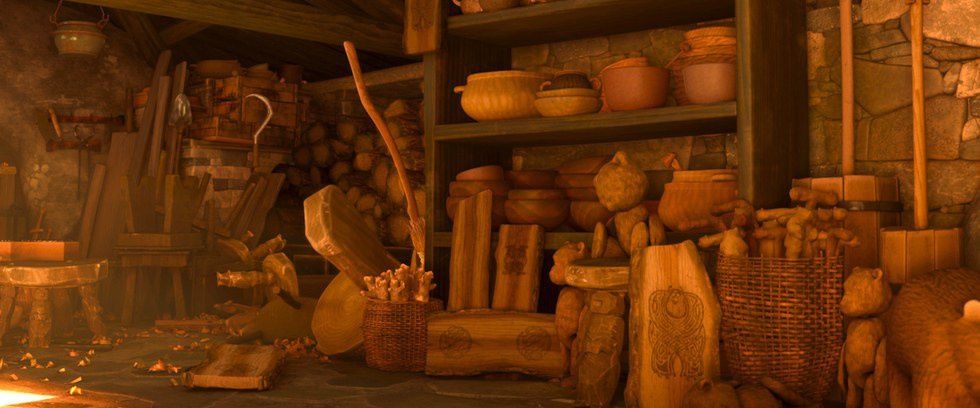The Pixar Theory has spread far and wide, even becoming the topic of a published book. This theory hypothesizes that all Pixar movies since 1995 are in the same universe, held together through the life of one small child. It is a very elaborate supposition, but also very fascinating. It all starts with the will of the wisps.

Ocean society is seen in Finding Nemo. The fish seem to have developed a school system and even a highway system. There is definitely social structure here among the sea life. This movie hints at the growing conflict between humans and animals. As animals gain intelligence, they are less content to have humans in superiority over them. Finding Dory continues these themes.
Ratatouille shows us the social structure of land animals, also separate from humans. It marks the intertwining of the two societies on the grand timeline of the Pixar Theory. Remy and his friends demonstrate to a small group of people how intelligent animals really are. Obviously, not everyone is pleased with this fact, so that small group tries to keep this fact under wraps. Yet the rumors of animal intelligence spread nonetheless.
Next we have Charles Muntz, from Up, who makes collars for his dogs to harness their intelligence. It is highly probable that he was inspired by the rumors spread after the events of Ratatouille. Even after their release, the dogs are none too pleased with the treatment they endured. Thus the animosity between humans and animals increases, and the rumors of animals’ potential soar. Humans develop new technology, forming a third industrial revolution hinted at in Up (remember all the construction and industrialization?). Yet, as humans are prone to do, they carry things too far, angering animals even more.
Machines have not been dormant during this time. In the quest to make better technology, Syndrome makes an omnidroid to take out the Supers in The Incredibles. The omnidroid turns on Syndrome and attacks humans in the city. Why? The omnidroid doesn’t have some grudge against humanity… does it?
Machines encompass toys and all inanimate objects in this theory. They get their intelligence from Zero Point Energy, as it's called by Syndrome, which seems remarkably similar to magic. Machines have been given much reason to be discontent. In the Toy Story movies, Sid’s toys revolt, Jessie resents her owner for abandoning her, and Lotso seriously despises humanity. It is clear that inanimate objects are quite fed up with the dominance humanity seems to have. After The Incredibles, they create the faceless organization Buy-n-Large, which is seen throughout the Pixar movies, usually on labels or newspapers.
You might be wondering how on earth Cars 1 and 2 fit into this theory. After all, there are no humans in those movies. However this fits perfectly with the grand storyline. We see the world with not humans, but with machines who seem to have adopted a lot of their culture from humanity. Contrast this with Wall-E, where the machines are almost all gone on earth. At the end of Cars 2, Allinol tries to turn cars away from alternative fuel, even though they were in an energy crisis. By raising paranoia, they are quite successful. Eventually they just ran out of fuel and the world fell into the disrepair seen in Wall-E. It’s likely that Wall-E himself did not die because his friendship with the cockroach gave him energy. At the end of Wall-E, they plant a tree. In the credits, we see it grow. Incidentally, it looks pretty similar to the tree in A Bug’s Life.
In A Bug’s Life, there are practically no humans. They are not evident nor referenced. Also, machines are pretty sparse. All that’s left in abundance are animals, who rebounded quickly after the apocalyptic war. It seems that as the species rebuild themselves, they live in some degree of peace.
Many, many years pass and these species mutate into… monsters! In Monsters Inc, they still need to power their city with humanity. Unfortunately, humanity has died out. So they use the doors. But rather than the doors leading to an alternate reality as suspected, they actually lead to a different period of time. Monsters are so terrified of humans because they know that if they interact with humans too much, their timeline could be drastically altered. This simple knowledge has expanded over the years to a general fear of humans.
Finally, back to the beginning. What happened to Boo when she grew up? The Pixar Theory suggests that she always wants to find her way back to Sully. So she tries everything, until she stumbles upon the time-traveling capabilities of wooden doors. She travels back to medieval times so she can have plenty of wood to experiment with and becomes the witch from Brave. This explains why she always disappears through doors in front of Merida. She has been experimenting with the will of the wisps to try and figure out more about Sully. The witch from Brave even has a carving of Sully, further cementing this theory. Can you spot it?
























